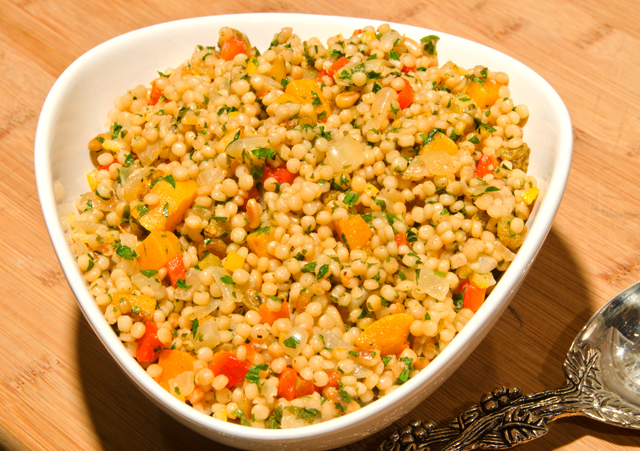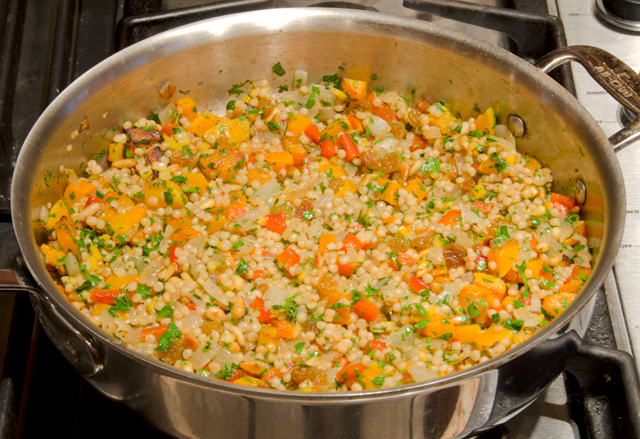
Now that the preserved lemons were ready, it was time to use them. In my research, I saw reference to a recipe that caught my attention, Israeli couscous with roasted butternut squash and preserved lemon. It was on the Epicurious website and I noted the original source was the September 1999 issue of Gourmet magazine. The issue is a part of my large food magazine library so I was able to see the recipe in it’s original context. The recipe was part of a larger menu, “Wedding in the City. When a caterer is out of the question.” The recipes had a definite Moroccan-middle eastern flair: caviar and hummus on pita toasts, grilled charmoula lamb chops, recipes for stuffed grape leaves and eggplant with cilantro vinaigrette. The fantasy wedding reception was scaled to serve fifty guests. Another article, “Without Ceremony” noted that the wedding banquet menu was too good to save for a special event and scaled some of the recipes, including the one for Israeli couscous, down to serve six.
The September 1999 issue of Gourmet was Ruth Reichl’s debut as editor-in-chief, a position she held until the magazine’s print version demise in November 2009. In this issue Pat Conroy took readers along in the “Romance of Umbria”, the late actor-writer Spalding Gray gave account of his adventures in Disney World with his wife and children. Described as a “great young American novelist” Ann Patchett wrote an essay called “Let Them Eat Kale.” Add to this Julia Child’s and Jacques Pepin’s roast chicken recipes and restaurant reporting by Pulitzer prize winner Jonathan Gold, it was quite an impressive issue, countless ads and all.
I made some changes to the original recipe. I used less squash and added a roasted pepper to the mix. You can either buy roasted peppers, or roast your own. I roasted a red bell pepper on my trusty asador. To add another flavor dimension, I toasted my Israeli couscous in the saute pan before cooking. If you have issue with pine nuts, chopped toasted walnuts would substitute nicely. Farro or even orzo could take the place of Israeli couscous. Served warm or at room temperature, the tangy-salty combination of the preserved lemon peel and juice are what makes this recipe truly stand out.
Israeli Couscous with Roasted Butternut Squash and Preserved Lemon
Serves 4-6
- 1 preserved lemon (see this post)
- 1 medium roasted sweet pepper, cut into 1/4″ dice
- 3c butternut squash, peeled, seeded and cut into 1/2″ dice
- 3T olive oil
- 1 medium sweet onion, chopped
- 1 1/4c low sodium chicken broth
- 1 1/4 cups Israeli couscous
- 1 (3 inch) cinnamon stick
- 1 bay leaf (Turkish)
- 1/2 c chopped fresh flat leaf parsley
- 1/2c chopped fresh cilantro
- 1/3c toasted pine nuts
- 1/2 c golden raisins
- Preheat oven to 450F.
- Cut enough preserved lemon peel into 1/4 inch dice to measure 1/4c, set aside.
- In a large bowl, toss squash cubes with 1T oil and salt to taste. Spread cubes in a large shallow baking pan. Check occasionally, tossing cubes with a spatula so they are evenly roasted on all sides and tender, about 15 minutes. Transfer cubes to a large bowl.
- Cook onion in 1T oil in a 10″ straight sided saute pan over medium high heat until golden. Add to the squash.
- Add diced roasted pepper to the squash and onions.
- Add 1T butter and 1T olive oil to same pan over medium heat. Add couscous, cinnamon stick, and bay leaf and stir until couscous browns slightly, stirring often, about 5 minutes. Add broth and salt and bring to boil. Reduce heat to low; cover and simmer until couscous is tender and liquid is absorbed, about 10 minutes.
- Add the vegetables into the couscous, stir to combine all ingredients. Transfer back to the large bowl, toss with 1T olive oil and 1T juice from the preserved lemons to coat.
- Add lemon peel, pine nuts, parsley, cilantro and pepper to taste. Adjust seasonings adding more of the preserved lemon juice if needed. Toss to coat well.
- Serve warm or at room temperature.
